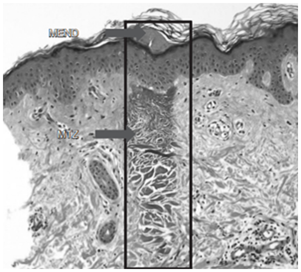
▶ Previous Artlcle: #13-1. Non-ablative Fractional Lasers
1550nm Fractional Laser
Then let’s take a closer look at non-ablative fractional lasers at each wavelength.
The 1550nm fractional laser uses Er:Glass as a medium and produces fractional laser beams in the way of scanner.
Although its main chromophore is water, it has a lower absorbance for water than 2940nm and 10600nm ablative fractional lasers.
.jpg)
[Advertisement] FCR® (Fractional Prickle CoralCalcium Regentron) – Manufacturer: (www.illglobal.com)]
As a result, the 1550nm fractional laser does not vaporize the tissue but only thermally denatures it, creating a microscopic necrotic column within the tissue (Figure 2).
The penetration depth within the tissue becomes much as absorbance is low, and the width and length of the microscopic necrotic column increase in proportion to pulse energy.
For example, the penetration depth within the tissue with 30mJ pulse energy is 980µm, which is about two times higher than that with 10mJ pulse energy (555µm) (Figure 3).
The 1550nm fractional laser has very various indications mainly for melasma, skin color, tone and texture, fine wrinkles, telangiectasis, pores, flush, acne, redness around acne lesions, etc.

Figure 2. Microscopic necrotic column by 1550 nm Fractional Laser (Source: Seung Ha Park, Fractional Laser: NAFL and AFL. Med Laser. 2015; 4(1): 1-9).
-To be continued



















